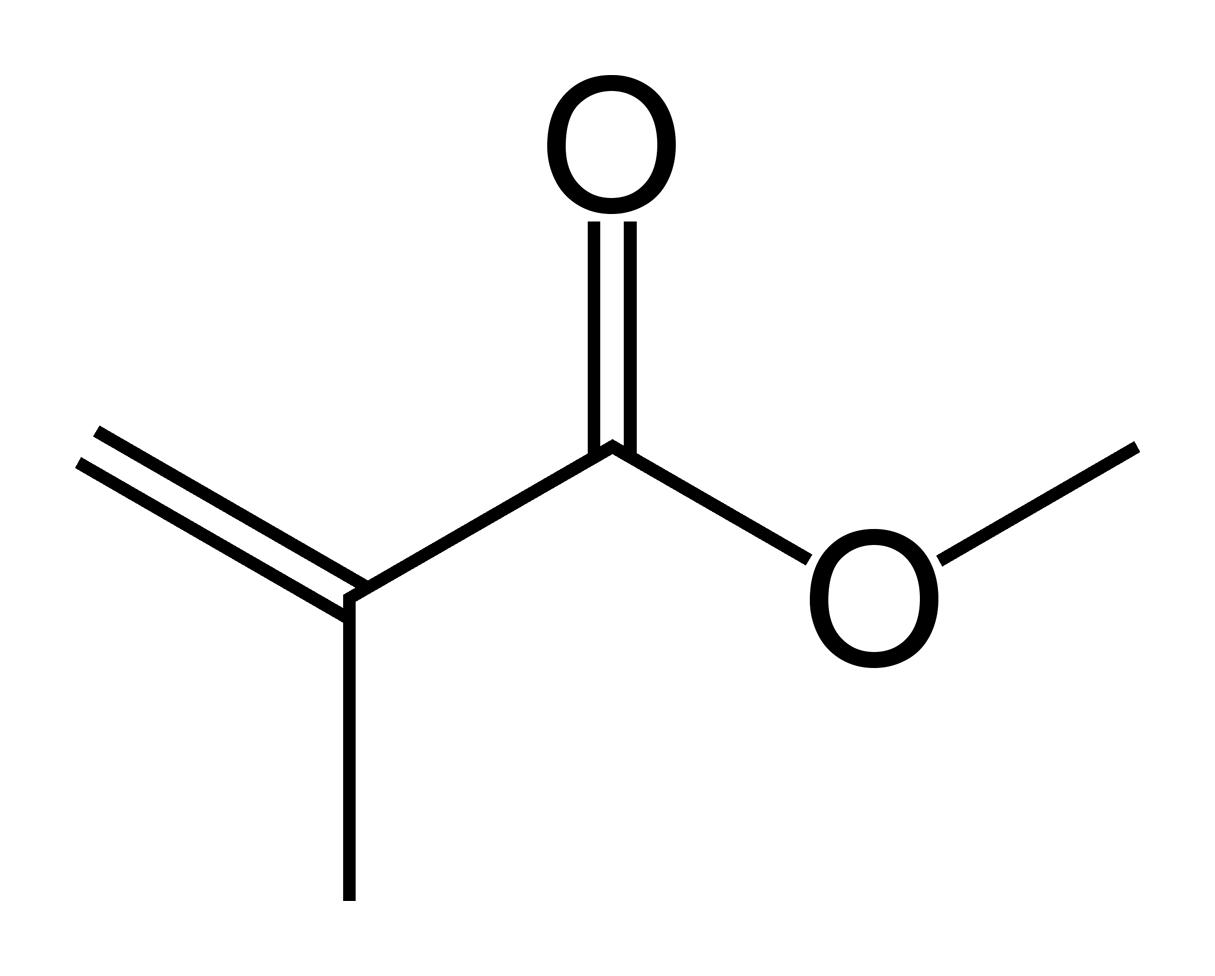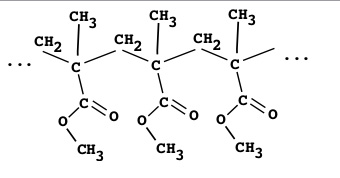Acrylic glass
Overview
Polymethyl methacrylate (PMMA) or poly (methyl 2-methylpropanoate) is the synthetic polymer of methyl methacrylate. This thermoplastic and transparent plastic is sold by the tradenames Plexiglas, Limacryl, R-Cast, Perspex, Plazcryl, Acrylex, Acrylite, Acrylplast, Altuglas, Polycast and Lucite and is commonly called acrylic glass or simply acrylic. The material was developed in 1928 in various laboratories and was brought to market in 1933 by Rohm and Haas Company.
Properties


The material is often used as an alternative to glass. Differences in the properties of the two materials include
- PMMA is less dense; its density can range from 1150-1190 kg/m3. This is less than half the density of glass which ranges 2400 to 2800 kg/m3.
- PMMA has a higher impact strength than glass and does not shatter but instead breaks into large dull pieces.
- PMMA is softer and more easily scratched than glass. This can be overcome with scratch-resistant coatings.
- PMMA is typically processed at a lower temperature than glass, just 240-250 °C.
- PMMA transmits up to 93% of visible light (per metre)[1]. A simple comparison with glass is not possible as glass is not a substance with a single composition and is made with an extreme range of optical transmittances from 0% to practically 100% (at least 99.99% infrared in long distance optical fibers).[2] Doped PMMA can achieve transmittances of 91% to 98%, suitable for consumer fiber.[3][4]
- Unlike glass, PMMA does not filter ultraviolet (UV) light. PMMA transmits UV light down to 300 nm. Some manufacturers[5] add a coating to PMMA sheets to make them absorb UV light. PMMA molecules have great UV stability compared to polycarbonate.
- PMMA allows infrared light of up to 2800 nm wavelength to pass. IR of longer wavelengths, up to 25,000 nm, are essentially blocked. Special formulations of colored PMMA exist to allow specific IR wavelengths to pass while blocking visible light (for remote control or heat sensor applications, for example).
PMMA can be joined using cyanoacrylate cement (so-called "Superglue"), or by using liquid di- or trichloromethane to dissolve the plastic at the joint which then fuses and sets, forming an almost invisible weld. PMMA can also be easily polished to restore cut edges to full transparency.
The refractive index of PMMA compounds usually ranges from 1.4893 to 1.4899 (a vacuum's is 1).
To produce 1 kg of PMMA, about 2 kg of petroleum is needed. In the presence of oxygen, PMMA ignites at 460° C and burns completely to form only carbon dioxide and water.
Related polymer poly(methyl acrylate)
The polymer of methyl acrylate, PMA or poly(methyl acrylate), is similar to poly(methyl methacrylate), except for the lack of methyl groups on the backbone carbon chain.[6] PMA is a soft white rubbery material that is softer than PMMA because its long polymer chains are thinner and smoother and can more easily slide past each other.
Uses
PMMA or Acrylic is a versatile material and has been used in a wide range of fields and applications.
Impact resistant substitute for glass
- PMMA Acrylic glass is commonly used for constructing residential and commercial aquariums.
- PMMA is used in the lenses of exterior lights of automobiles. [7]
- The spectator protection in ice hockey stadiums is made of PMMA.
- Motorcycle helmet visors
- Police vehicles for riot control often have the regular glass replaced with acrylic to protect the occupants from thrown objects.
- Acrylic is used for viewing ports and even complete hulls of submersibles, such as the Alicia submarine's viewing spheres and the Bathyscaphe Trieste's windows.
- Polycast acrylic sheet is the most widely used material in aircraft transparencies (windows). In applications where the aircraft is pressurized, stretched acrylic is used.
Medical technologies and implants
- PMMA has a good degree of compatibility with human tissue, and can be used for replacement intraocular lenses in the eye when the original lens has been removed in the treatment of cataracts. Hard contact lenses are frequently made of this material. Soft contact lenses are often made of a related polymer, where acrylate monomers containing one or more hydroxyl groups make them hydrophilic.
- In orthopaedics, PMMA bone cement is used to affix implants and to remodel lost bone. It is supplied as a powder with liquid methyl methacrylate (MMA). When mixed these yield a dough-like cement that gradually hardens. Surgeons can judge the curing of the PMMA bone cement by pressing their thumb on it. Although PMMA is biologically compatible, MMA is considered to be an irritant and a possible carcinogen. PMMA has also been linked to cardiopulmonary events in the operating room due to hypotension. [8] Bone cement acts like a grout and not so much like a glue in arthroplasty. Although sticky, it primarily fills the spaces between the prosthesis and the bone preventing motion. It has a Young's modulus between cancellous bone and cortical bone. Thus it is a load sharing entity in the body not causing bone resorption. [9]
- Dentures are often made of PMMA, and can be colour-matched to the patient's teeth. In cosmetic surgery, tiny PMMA microspheres suspended in some biological fluid are injected under the skin to reduce wrinkles or scars permanently.
Artistic and aesthetic uses
- Acrylic paint essentially consists of PMMA suspended in water; however since PMMA is hydrophobic, a substance with both hydrophobic and hydrophilic groups needs to be added to facilitate the suspension.
- Modern furniture makers, especially in the 1960s and 1970s, seeking to give their products a space age esthetic incorporated Lucite and other PMMA products into their designs, especially office chairs. Many other products (for example, guitars) are sometimes made with acrylic glass, giving otherwise ordinary objects a transparent or futuristic look.
- Perspex has been used as a surface to paint on, for example by Salvador Dalí.
- Occasionally used as a glass substitute in picture framing, due to its relatively inexpensive cost, light weight, and shatter-resistant nature, as well as the fact that it can be ordered in larger sizes than standard picture-framing glass. Conventional glass may or may not be preferred.
- From approximately the 1960s onward, sculptors and glass artists began using acrylics, especially taking advantage of the material's flexibility, light weight, cost and its capacity to refract and filter light.
Other uses
- The material is used to produce laserdiscs, and sometimes also for DVDs, but the more expensive polycarbonate (also used for CDs) has better properties when exposed to moisture.
- Artificial fingernails are made of acrylic.
- In the 1960s, luthier Dan Armstrong developed a line of electric guitars and basses whose bodies were made completely of acrylic. These instruments were marketed under the Ampeg brand. Ibanez [10] and BC Rich have also made acrylic guitars.
- Recently a blacklight-reactive tattoo ink using PMMA microcapsules was developed. This ink is reportedly safe for use, and claims to be Food and Drug Administration (FDA) approved for use on wildlife that may enter the food supply.
- In semiconductor research and industry, PMMA aids as a resist in the electron beam lithography process. A solution consisting of the polymer in a solvent is used to spin coat silicon wafers with a thin film. Patterns on this can be made by an electron beam (using an electron microscope), deep UV light (shorter wavelength than the standard photolithography process), or X-rays. Exposure to these creates chain scission or (de-cross-linking) within the PMMA, allowing for the selective removal of exposed areas by a chemical developer, making it a positive photoresist. PMMA's advantage is that it allows for extremely high resolution (nanoscale) patterns to be made. It is an invaluable tool in nanotechnology.
- Small strips of PMMA are used as dosimeter devices during the Gamma Irradiation process. The optical density of PMMA changes as the Gamma dose increases and can be measured with a spectrophotometer.
- It is used as a light guide for the backlights in TFT-LCDs.
- Plastic optical fiber used for short distance communication is made from PMMA, and perfluorinated PMMA, clad with fluorinated PMMA, in situations where its flexibility and cheaper installation costs outweigh its poor heat tolerance and higher attenuation over glass fiber.
- Ludwig-Musser makes a line of acrylic drums called Vistalites. They are well known as being used by Led Zeppelin drummer John Bonham.
See also
- Other transparent plastics: polystyrene, polycarbonate
References
- ↑ MatWeb material property database - Overview of General Purpose Acrylic molding resin
- ↑ Fiber Optic Cable Tutorial ARC Electronics, 'optical fiber attenuation ranges from 0.5dB/km' (99.988% transmission per metre)
- ↑ Basics of Plastic Optical Fiber (Part 2) MITSUBISHI RAYON CO., LTD., 2003, 'POF is not suitable for long-distance transmission. compared with quartz fiber, there is a large transmission loss', PMMA graph shows 0.25 db/m loss (94.4% transmission) at 400nm (violet), improving to 0.08 db/m loss (98.2 % transmission) from 500 to 580nm (green, yellow), worsening to 0.44 db/m (91.2% transmission) at 620 (orange) and 700nm (red) with a trough of 0.14 db/m (96.8% transmission) at 650nm (orange red)
- ↑ American Computer Optics 18in Tempered LCD Glass MatWeb material property database, 'Transmission, Visible 98 %'
- ↑ Altuglas International Plexiglas UF-3 UF-4 and UF-5 sheets
- ↑ Polymethyl acrylate and polyethyl acrylate, Encyclopædia Britannica
- ↑ Kutz, Myer, Handbook of Materials Selection. John Wiley & Sons 2002. pg 341
- ↑ American Journal of Neuroradiology, 23:601-604, April 2002.
- ↑ Miller, Review of Orthopaedics, 4th Edition, p 129.
- ↑ http://www.ibanezregister.com/Gallery/js/gal-js2k.htm and http://ibanez.com/eg/guitar.aspx?m=JEM20TH
ca:Metacrilat da:Akryl de:Polymethylmethacrylat id:Kaca akrilik it:Polimetilmetacrilato he:זכוכית אקרילית hu:Plexiüveg nl:Polymethylmethacrylaat fi:Akryyli sv:Polymetylmetakrylat